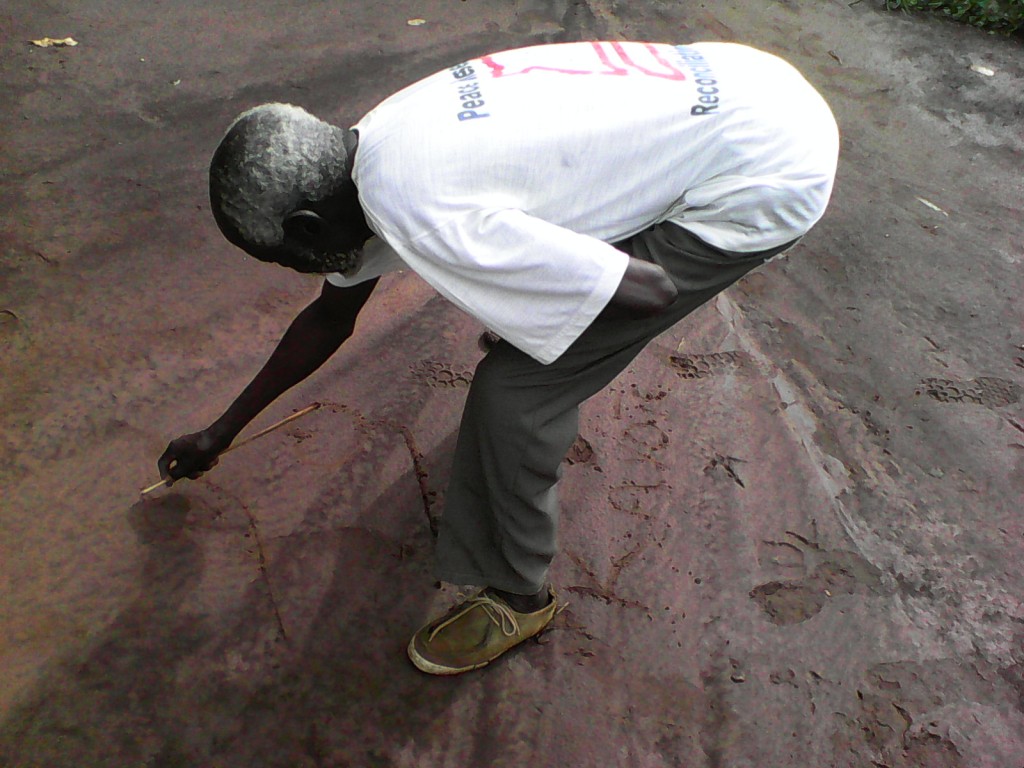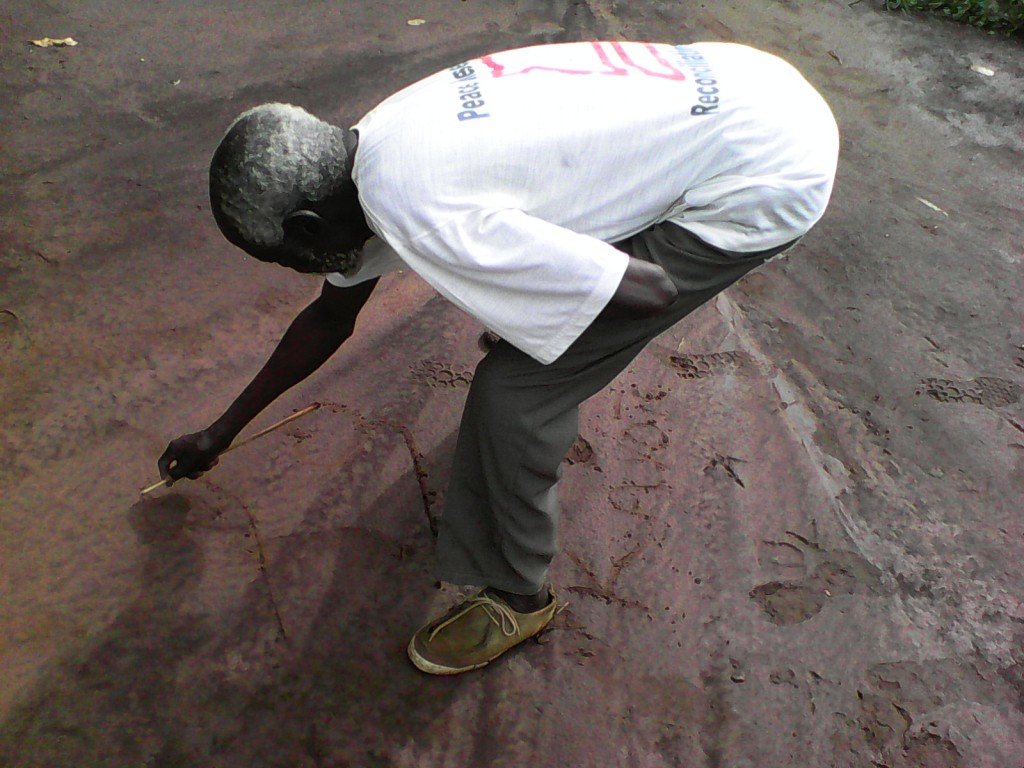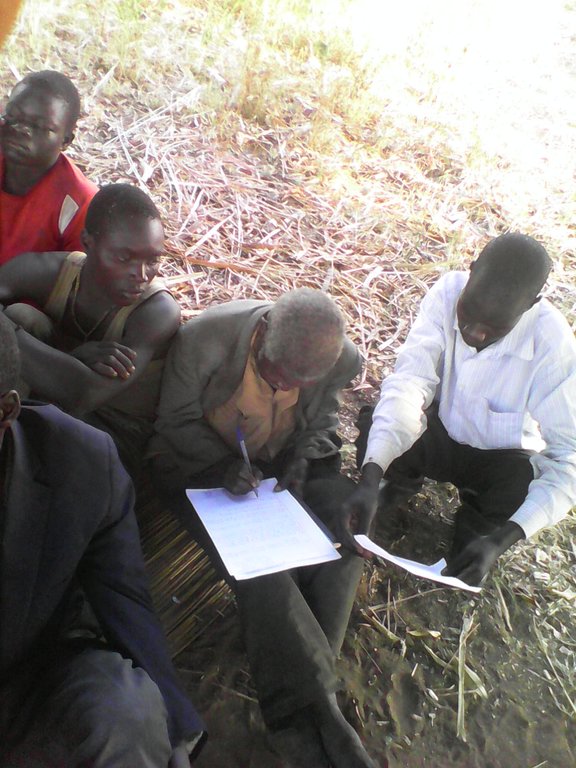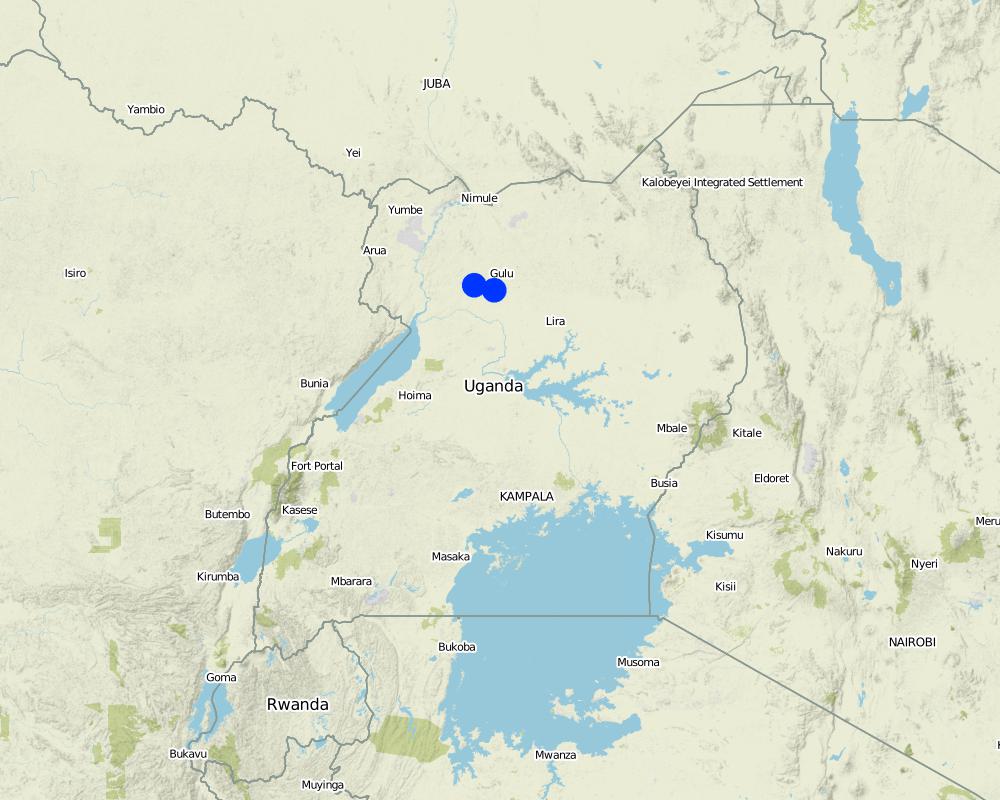Peer farmers as a village resource person for scaling Climate-Smart Agriculture (CSA) Practices [乌干达]
- 创建:
- 更新:
- 编制者: Sunday Balla Amale
- 编辑者: JOY TUKAHIRWA, Kamugisha Rick Nelson
- 审查者: John Stephen Tenywa, Nicole Harari
Lawang Lupur (Rwot Kweri)
approaches_3323 - 乌干达
查看章节
全部展开 全部收起1. 一般信息
1.2 参与方法评估和文件编制的资源人员和机构的联系方式
关键资源人员
土地使用者:
Odong Kilama
0777229172
Farmer
Laliya, Agung, Akaka Sub-county
乌干达
Sunday Micheal
+256782139465
Farmer
gweno twom south, Nwoya village, Alero sub county, Nwoya District
乌干达
有助于对方法进行记录/评估的项目名称(如相关)
Scaling-up SLM practices by smallholder farmers (IFAD)有助于对方法进行记录/评估的机构名称(如相关)
Uganda Landcare Network (ULN) - 乌干达1.3 关于使用通过WOCAT记录的数据的条件
(现场)数据是什么时候汇编的?:
12/12/2017
编制者和关键资源人员接受有关使用通过WOCAT记录数据的条件。:
是
1.4 SLM技术问卷的参考
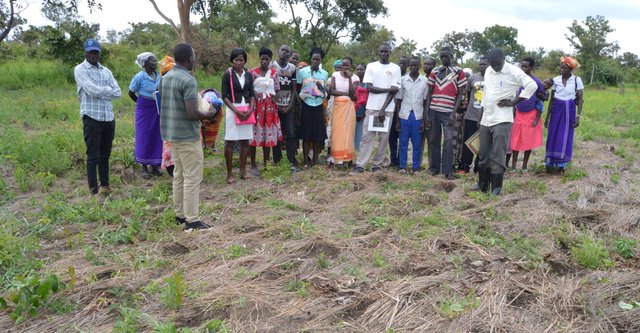
Conservation Farming Basins In Annual Crops For Water … [乌干达]
CF basins are constructed in the field to act as water storage containers. Water is conserved within the basins and plants can survive with this conserved water during periods of little rainfall and dry spells.
- 编制者: Sunday Balla Amale
2. SLM方法的描述
2.1 该方法的简要说明
A prosocial behavior approach, where a peer farmer identified by other local farmers is trained on a technology and then used as a trainer for the fellow farmers (farmer group or neighbors).
2.2 该方法的详细说明
该方法的详细说明:
Adoption of sustainable agricultural practices requires an in-depth understanding of the implementation, sustainability and the opportunity cost involved. Empowered local resource persons known as peer farmers are used by the International Center for Tropical Agriculture (CIAT) and International Institute of Tropical Agriculture (IITA) in Northern Uganda as channels to ensure that farmers understand the importance and implementation of Climate Smart Agricultural (CSA) Practices such as using conservation farming (CF) permanent basins.
A peer farmer in this case is a local community member whom the farmers identify as a potential trainer, very cooperative and, if trained would be willing to share the knowledge with other farmers in that community. After training the peer farmers, an incentive is promised to them based on their performance over time. This incentive is a commodity that is very cheap, but valuable, and not usually a farm input. In this case weighing scale was used as an incentive.
The peer farmer then uses all available methods and channels to pass on to the knowledge to other folks. The acquired knowledge and skills are usually shared through community meetings, religious gatherings, market places and so on.
The process of implementing this approach includes: Identifying the place of implementation, working with the farmers to identify a potential peer farmer, training the peer farmer, the peer farmer training other farmers over time and monitoring the progress of knowledge spill over. Stakeholders involved: Field staff - Work with farmers to identify and train peers, monitor activities; local leaders - organize community members; peer farmer - attend training, train other farmers.
This method is cheap, farmers identify someone with fairly good pro-social behavior, and farmers would be willing to learn from their own village member.
2.3 该方法的照片
2.5 采用该方法的国家/地区/地点
国家:
乌干达
区域/州/省:
Nwoya District
有关地点的进一步说明:
Alero Sub-county
Map
×2.6 该方法的开始和终止日期
注明开始年份:
2015
若不知道准确的年份,请注明该方法的大致开始日期。:
不到10年前(最近)
2.7 方法的类型
- 基于项目/方案
2.8 该方法的主要目的/目标
Promoting adoption of Climate-Smart Agriculture through prosocial behaviour
2.9 推动或妨碍实施本办法所适用的技术的条件
社会/文化/宗教规范和价值观
- 启动
traditional relations among local communities
- 阻碍
limited cooperation among some communities
机构设置
- 启动
Agricultural Advisory services in the country, more NGOs operating in the agricultural sector
参与者的的协作/协调
- 启动
Participatory involvement of all the stakeholders in the agricultural sector
政策
- 启动
PMA-Plan for Modernisation of Agriculture, a Government policy aimed at ensuring adoption of modern farming technologies.
Policy Action on climate change adaptation
Vision 2040 - A government policy aims at transforming Uganda's agriculture from subsistence to commercial farming.
了解SLM,获得技术支持
- 启动
Trainings from different agencies
- 阻碍
costs to fund the training of peer farmers
市场(购买投入,销售产品)和价格
- 启动
high demands for food produce and favorable market prices with good roads
- 阻碍
middle men cheat poor farmers
工作量、人力资源可用性
- 启动
use local people at their own times
- 阻碍
illiteracy
3. 相关利益相关者的参与和角色
3.1 该方法涉及的利益相关者及其职责
- 当地土地使用者/当地社区
farmers and local leaders
implement the technology
- 社区组织
farmer groups
used as a channel
- SLM专家/农业顾问
extension workers
train on the SLM technologies
- 研究人员
CIAT/IITA
Assess the degree of resilience
- 国际组织
CIAT/IITA
funding research activities
如果涉及多个利益相关者,请注明领导机构:
CIAT
3.2 当地土地使用者/当地社区参与该方法的不同阶段
| 当地土地使用者/当地社区的参与 | 指定参与人员并描述活动 | |
|---|---|---|
| 启动/动机 | 外部支持 | CIAT project promoting food security and farming systems resilience in East Africa through wide-scale adoption of climate smart agriculture. The project is implemented in Nwoya district, designed by CIAT and funded by IFAD. |
| 计划 | 外部支持 | CIAT/IITA: IITA became partner organisation for the project. Staffing was done through IITA, implemented in collaboration with IITA Uganda. |
| 实施 | 互动 | CIAT, IITA, Local government, National Agricultural Research Organisation, ZOA, Farmers, Extension agents |
| 监测/评估 | 互动 | Participatory monitoring and evaluation involving all parties through farmers field days |
3.3 流程图(如可用)
3.4 有关SLM技术选择的决策
具体说明谁有权决定选择要实施的技术:
- 所有相关参与者,作为参与式方法的一部分
明确做出决策的依据:
- 对充分记录的SLM知识进行评估(基于证据的决策)
- 研究结果
4. 技术支持、能力建设和知识管理
4.1 能力建设/培训
是否为土地使用者/其他利益相关者提供培训?:
是
明确受训人员:
- 土地使用者
如果相关,请说明性别、年龄、地位、种族等。:
adults
培训形式:
- 公开会议
4.2 咨询服务
土地使用者有权使用咨询服务吗?:
是
指明是否提供了咨询服务:
- 在土地使用者的土地上
说明/注释:
planned visits to peer farmers fields to observe what they are doing and advising them accordingly.
4.3 机构强化(组织发展)
是否通过这种方法建立或加强了机构?:
- 是,少许
具体说明机构的强化或建立程度:
- 本地
说明机构、角色和职责、成员等。:
local farmer groups
具体说明支持类型:
- 能力建设/培训
4.4 监测和评估
监测和评估是该方法的一部分吗?:
是
若是,该文件是否用于监测和评估?:
否
4.5 研究
研究是该方法的一部分吗?
是
明确话题:
- 社会学
- 经济/市场营销
提供进一步的细节,并指出是谁做的研究:
CIAT/IITA Research in Northern Uganda under the project; Promoting food security and farming systems resilience in East Africa through wide scale adoption of climate smart Agriculture (CSA)
5. 融资和外部物质支持
5.1 该方法中SLM组成部分的年度预算
如果不知道准确的年度预算,请给出一个范围:
- 2,000-10,000
5.2 为土地使用者提供财政/物质支援
土地使用者是否获得实施该技术的财政/物质支持?:
否
5.3 对特定投入的补贴(包括劳动力)
- 无
如果土地使用者的劳动力是一项重要的投入,那么是不是:
- 自愿
5.4 信用
是否根据SLM活动的方法给予信用值?:
否
5.5 其它激励或手段
是否有其他激励措施或工具用于促进SLM技术的实施?:
是
如果是,请具体说明:
weighing scale for best performers
6. 影响分析和结论性陈述
6.1 方法的影响
该方法是否有助于当地土地使用者,提高利益相关者的参与度?:
- 否
- 是,很少
- 是,中等
- 是,支持力度很大
yes, improved group work
这种方法是否有助于基于证据的决策?:
- 否
- 是,很少
- 是,中等
- 是,支持力度很大
decision made by community members
该方法是否帮助土地使用者实施和维护SLM技术?:
- 否
- 是,很少
- 是,中等
- 是,支持力度很大
incentive driven
该方法是否提高了SLM的协调性和成本效益?:
- 否
- 是,很少
- 是,中等
- 是,支持力度很大
farmers working with each other
该方法是否调动/改善了使用财务资源实施SLM的途径?:
- 否
- 是,很少
- 是,中等
- 是,支持力度很大
promoted group work but directed towards technology transfer
该方法是否提高了土地使用者实施土地管理的知识和能力?:
- 否
- 是,很少
- 是,中等
- 是,支持力度很大
new technologies
该方法是否提高了其他利益相关者的知识和能力?:
- 否
- 是,很少
- 是,中等
- 是,支持力度很大
mostly farmers involved
该方法是否建立/加强了机构、利益相关者之间的合作?:
- 否
- 是,很少
- 是,中等
- 是,支持力度很大
different stakeholders participated
该方法是否缓解了冲突?:
- 否
- 是,很少
- 是,中等
- 是,支持力度很大
improved social relations
该方法是否有助于社会和经济弱势群体?:
- 否
- 是,很少
- 是,中等
- 是,支持力度很大
did not focus on well off farmers, just anyone whom the community thinks has the potential to train local members
该方法是否改善了性别平等并赋予女性权力?:
- 否
- 是,很少
- 是,中等
- 是,支持力度很大
50% of trainers were women and at the end they performed better than the men trainers
该方法是否鼓励年轻人/下一代土地使用者参与SLM?:
- 否
- 是,很少
- 是,中等
- 是,支持力度很大
ensure transfer to local people
该方法是否改善了阻碍SLM技术实施的土地使用权/用户权问题?:
- 否
- 是,很少
- 是,中等
- 是,支持力度很大
该方法是否改善了粮食安全/改善了营养?:
- 否
- 是,很少
- 是,中等
- 是,支持力度很大
much higher increase in production
该方法是否改善了市场准入?:
- 否
- 是,很少
- 是,中等
- 是,支持力度很大
good quality products
该方法是否改善了供水和卫生条件?:
- 否
- 是,很少
- 是,中等
- 是,支持力度很大
farm based
该方法是否带来了更可持续的能源使用?:
- 否
- 是,很少
- 是,中等
- 是,支持力度很大
farm based
该方法是否提高了土地使用者适应气候变化/极端情况和减轻气候相关灾害的能力?:
- 否
- 是,很少
- 是,中等
- 是,支持力度很大
该方法是否会带来就业、收入机会?:
- 否
- 是,很少
- 是,中等
- 是,支持力度很大
to trainers of peer farmers
6.2 土地使用者实施SLM的主要动机
- 增加生产
reduced crop failure since farmers learnt better water conservation methods
- 增加利润(能力),提高成本效益比
higher yields with lower investments
- 减少土地退化
reduced erosion and surface flow
- 降低灾害风险
crops do not fail during dry spells
- 减少工作量
performed once every 3 years, no need for irrigation
- 声望、社会压力/社会凝聚
working and training each other
- 加入运动/项目/团体/网络
local group driven approach
- 环境意识
farmers learnt how important it is to conserve soils
- 提高SLM知识和技能
through trainings and social group work
- 美学改进
good quality product
- 冲突缓解
good community relations
6.3 方法活动的可持续性
土地使用者能否维持通过该方法实施的措施(无外部支持的情况下)?:
- 是
若是,请说明如何维持:
The knowledge becomes local to the farmers; observes direct benefits whitin the shortest time of implementation, learn other things from neighbors without need for any motivation
6.4 该方法的长处/优点
| 土地使用者眼中的长处/优势/机会 |
|---|
| farmers can easily learn from each other |
| peer trains farmers within their local environment |
| 编制者或其他关键资源人员认为的长处/优势/机会 |
|---|
| All available methods of passing information about the technologies are at the peer farmers disposal eg. market points, church, group meetings, tribal gatherings |
| farmers use their local language to teach/demonstrate to each other |
6.5 该方法的弱点/缺点以及克服它们的方法
| 土地使用者认为的弱点/缺点/风险 | 如何克服它们? |
|---|---|
| difficult to train peer farmers | use practicals |
| peer farmers may not retain all the knowledge about the technology | use charts/pictures |
| 编制者或其他关键资源人员认为的弱点/缺点/风险 | 如何克服它们? |
|---|---|
| costly to organise trainings for peers | use local education facilities such as schools for training peer farmers |
7. 参考和链接
7.1 方法/信息来源
- 实地考察、实地调查
2
- 与土地使用者的访谈
3
- 与SLM专业人员/专家的访谈
1
链接和模块
全部展开 全部收起链接

Conservation Farming Basins In Annual Crops For Water … [乌干达]
CF basins are constructed in the field to act as water storage containers. Water is conserved within the basins and plants can survive with this conserved water during periods of little rainfall and dry spells.
- 编制者: Sunday Balla Amale
模块
无模块


